Intel Core i7-10710U Benchmarked: 14nm+++ Comet Lake
Time to become back into some CPU benchmarking, and we're not looking at whatever old CPU, but the first of Intel's 10th-generation processors. As you lot probably know, there aren't whatsoever desktop 10th-gen parts in sight just yet, merely Intel has been doing some interesting stuff on the laptop side.
Intel'southward tenth-gen lineup is admittedly confusing because of the split in architectures and fabrication. I group of processors utilize Intel's long awaited 10nm process, that's codenamed Ice Lake and information technology brings ii major improvements: a new Sunny Cove CPU core with a boost to IPC, and Gen11 graphics with more than execution units and new features.
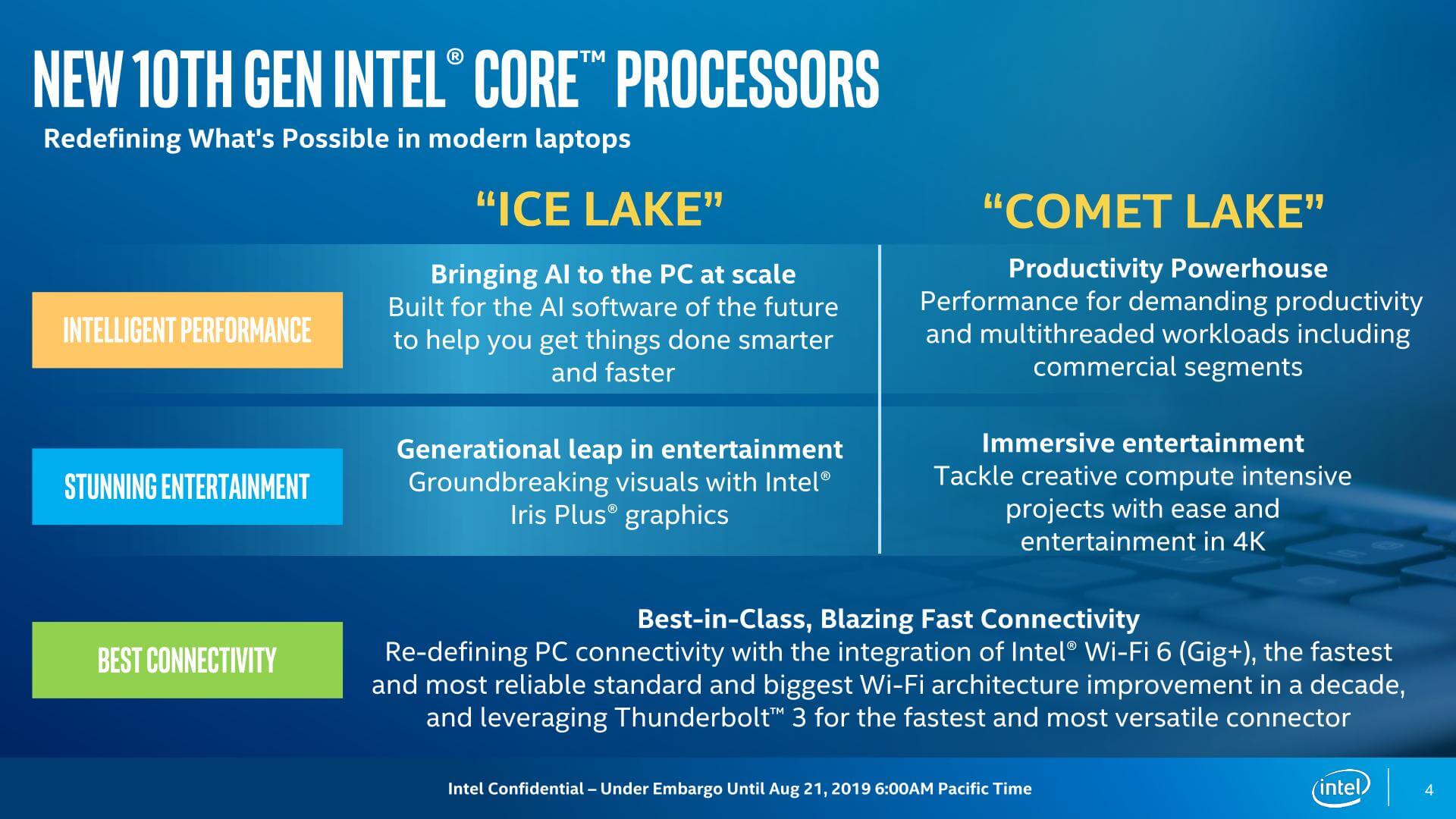
The other grouping of processors are Comet Lake, these are some other refinement of Skylake on 14nm. We're not quite certain how many pluses nosotros have to add to the end there, but it'southward certainly a few now. Comet Lake brings no major updates to the microarchitecture or integrated graphics, only nosotros do go faster retentiveness and Wi-Fi six support.
At present, both product lines coexist in the same generation for the same course of products. Comet Lake consists of 15W U-series parts, while Ice Lake also has 15W parts, along with a few 9W and 28W models. Then when buying an ultraportable laptop, substantially you'll have a choice betwixt Comet and Water ice Lake depending on the model.
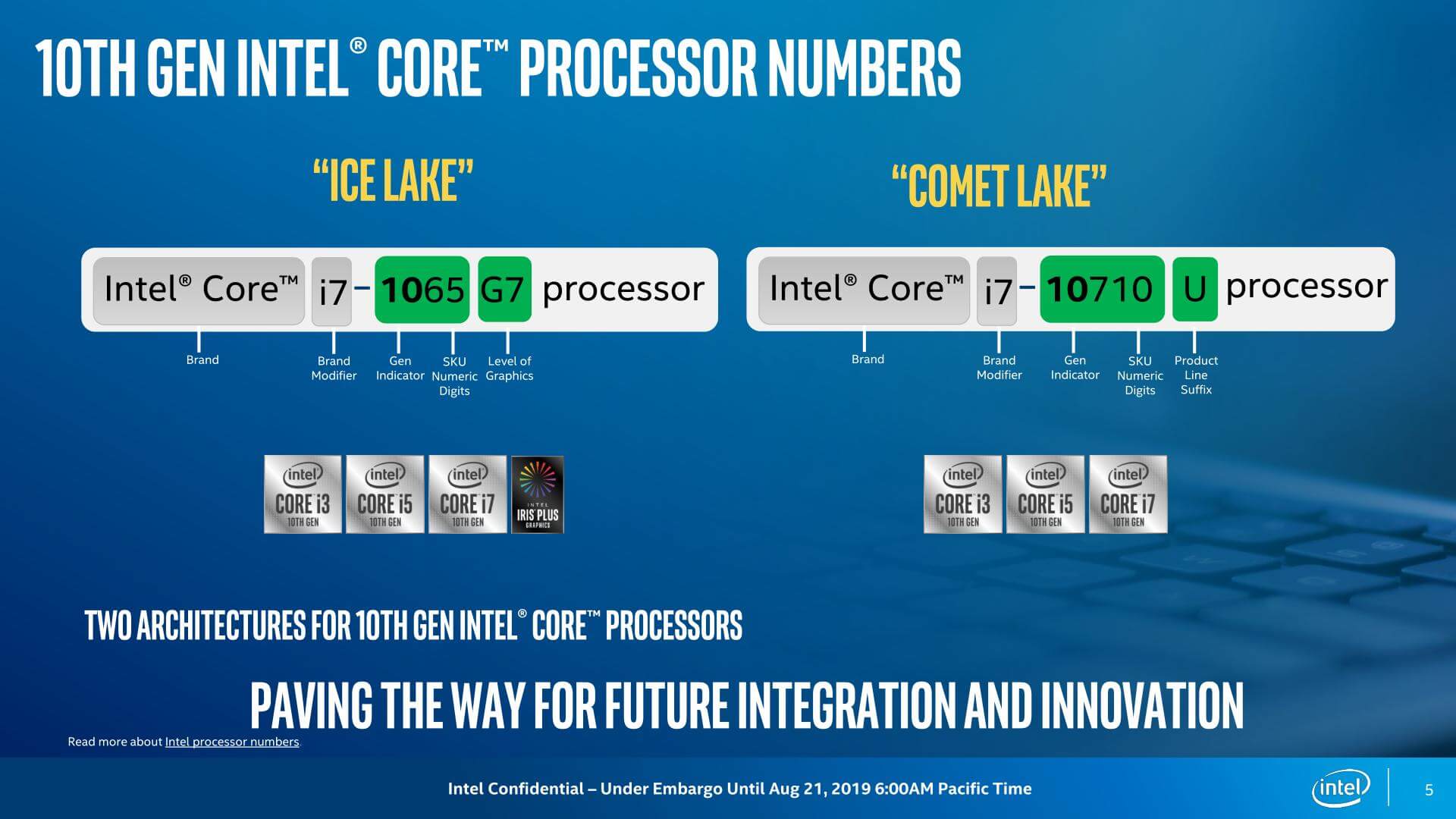
Each line of CPUs has its own benefits. Water ice Lake brings a large leap in integrated graphics performance, but it'south limited to four CPU cores at small-scale clock speeds, topping out at iii.nine GHz for the 15W models. Comet Lake has the same crappy integrated graphics nosotros've had for generations, but with much higher CPU clock speeds (upwardly to four.9 GHz) and a new vi-cadre configuration for the top-end Core i7. Indeeed, Intel has somehow managed to bring half-dozen cores into a 15W parcel.
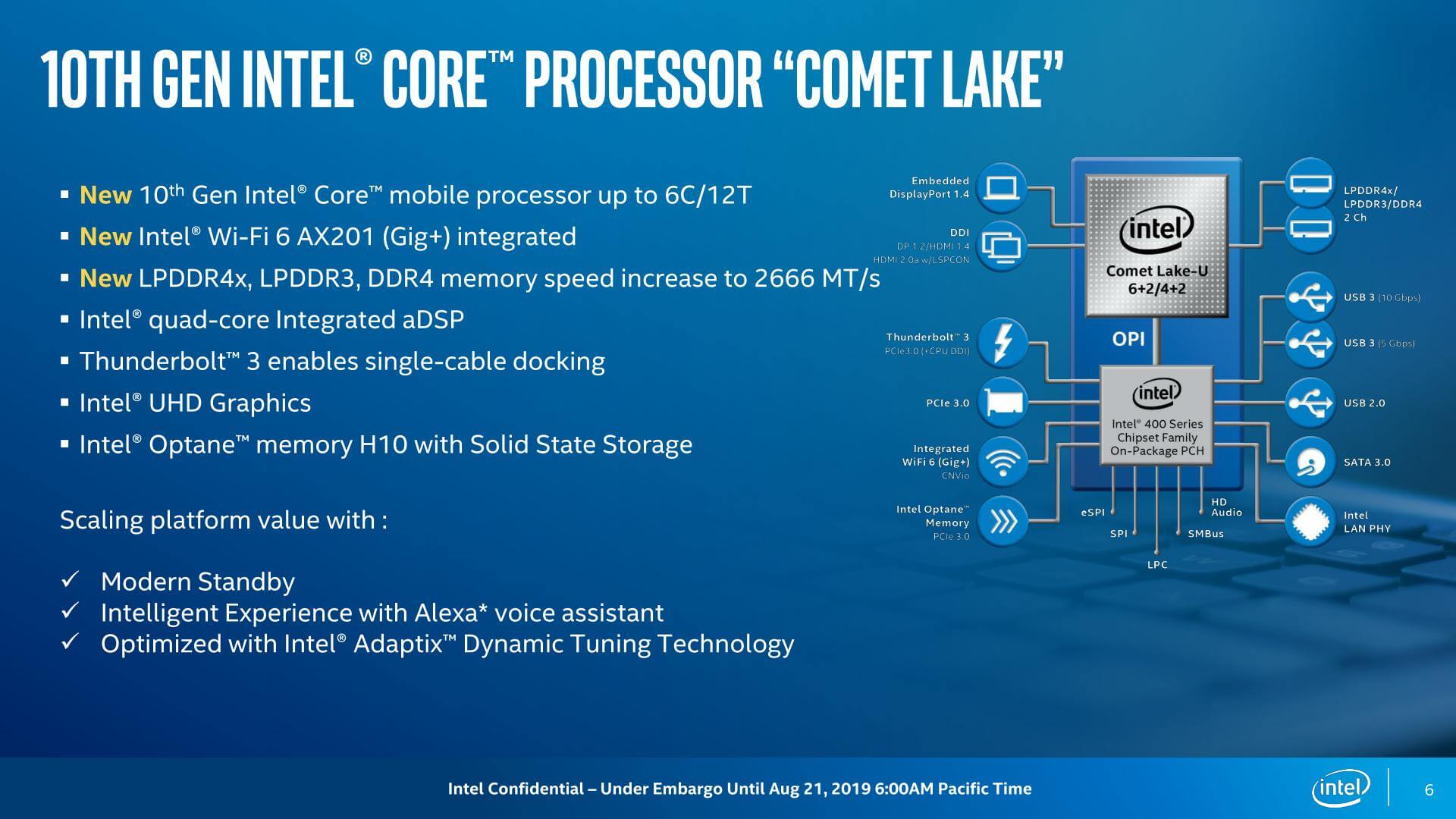
On paper, it looks like Comet Lake is the option for the all-time CPU operation, and Ice Lake for GPU operation, however this is muddied past some vendors including discrete GPUs, so it'due south not that elementary.
The naming scheme is horrendous. Ice Lake processors are called stuff like Cadre i7-1065G7 for the height-end 15W Cadre i7, while Comet Lake receives the equally awful Core i7-10710U. Six letters or numbers for each processor's model name is too many and for the average buyer, how the are they supposed to tell what the difference is between a 1065G7 and a 10710U. These names need a massive simplification or a split into two line-ups to make the departure more obvious.
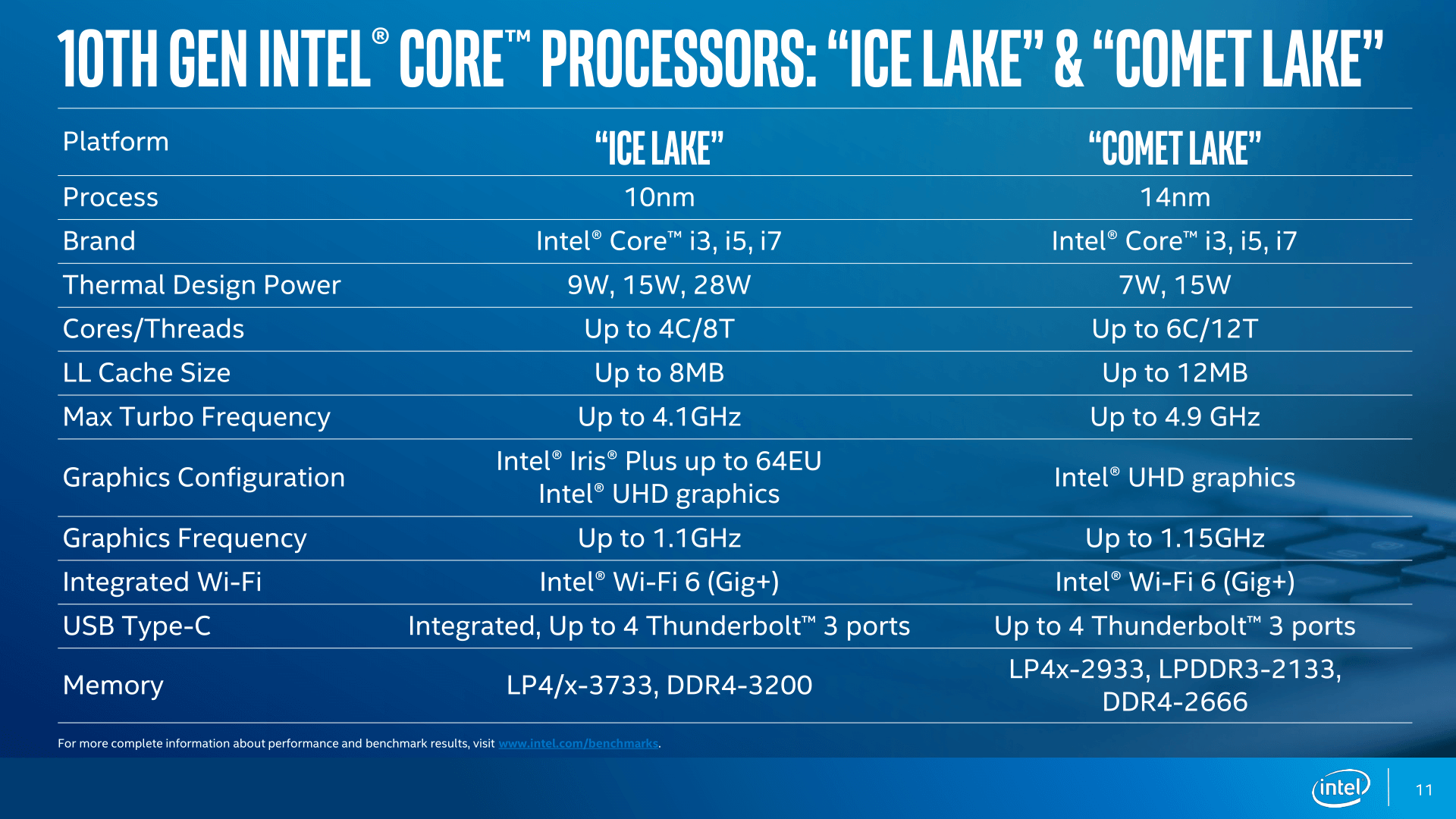
All that information aside, we'll be looking at Comet Lake first, and and so hopefully in a few weeks when Water ice Lake machines start arriving to our labs, we tin swoop into that as well.
Now you might be thinking, all the same some other 14nm product lineup isn't that exciting, but that's not really the example. Like with Kaby Lake Refresh that saw a spring from 2 to 4 cores for ultraportable laptops, and brought with information technology a performance increase, Comet Lake brings a jump from 4 to six cores.
At the moment this is only with i product in the lineup, the tiptop end Core i7-10710U. Other Comet Lake CPUs, such as the Core i7-10510U and the Cadre i5s remain four cores, and then Cadre i3s and below are dual-cores. Today'south review is a full benchmark breakup of the Core i7-10710U, and so we'll be able to come across the benefits of bringing 6 cores into such a tight ability envelope, with a follow-up characteristic exploring how the Core i5 models step things up a notch, too.
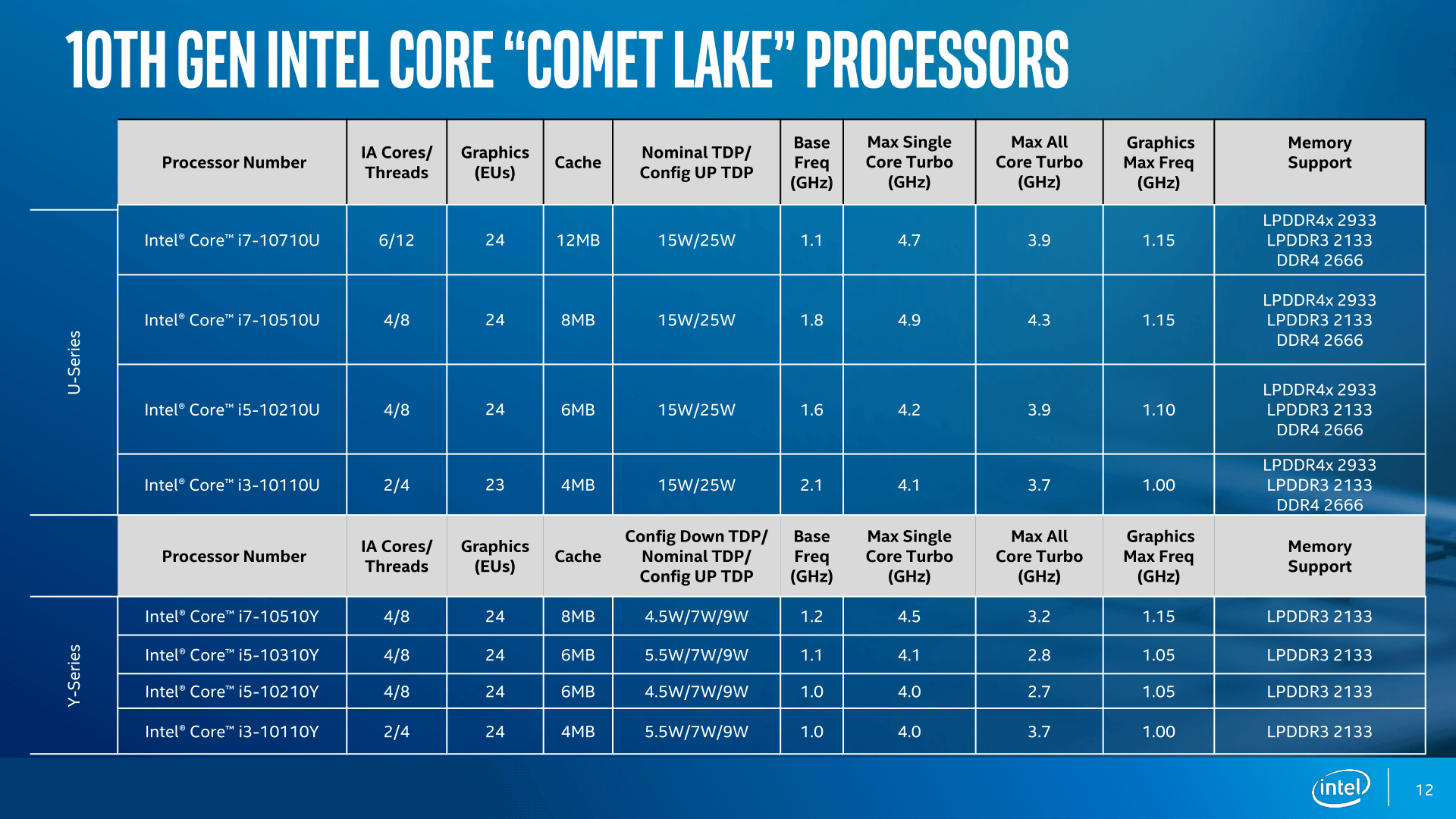
Compared to other Core i7s from the past few generations, the obvious headline feature hither are the 6 cores and 12 threads, but to include this many cores within the same 15W TDP equally previous generations, clock speeds have had to drib. The base clock now sits at 1.ane GHz compared to every bit high equally i.9 GHz with the Core i7-8665U, and boost clocks take also seen a slight reduction from iv.eight GHz in the previous gen, and four.nine GHz with the new Comet Lake quad-core option.
What nearly all-core turbos? Intel doesn't typically advertise this, merely we know the Core i7-8565U sits at iv.1 GHz on iv cores. The Cadre i7-10710U hits 3.ix GHz across six cores at its maximum, however it still does 4.1 GHz on iv cores, so we're not losing anything in workloads that use the same number of cores. It'due south simply the 10710U tin can also push out to six cores if necessary, at lower clock speeds.
The other reward the six-core model brings is an increase to cache, now sitting at 12 MB, which matches Intel's half dozen-core Coffee Lake processors. However, at that place's no upgrades to the GPU, and then nosotros're getting another UHD 620 with 24 execution units and clock speeds up to 1150 MHz. This is a slow GPU, then don't be surprised if many OEMs pair this CPU with a low-power discrete option like Nvidia's MX250.
Testing Platform
The test platform for today's benchmark is the MSI Prestige fourteen A10SC. This super neat laptop packs the Core i7-10710U inside, while as well featuring an Nvidia GeForce GTX 1650 Max-Q GPU and 16GB of dual-channel DDR4 retentivity, making for a powerful 14-inch slim and light auto.
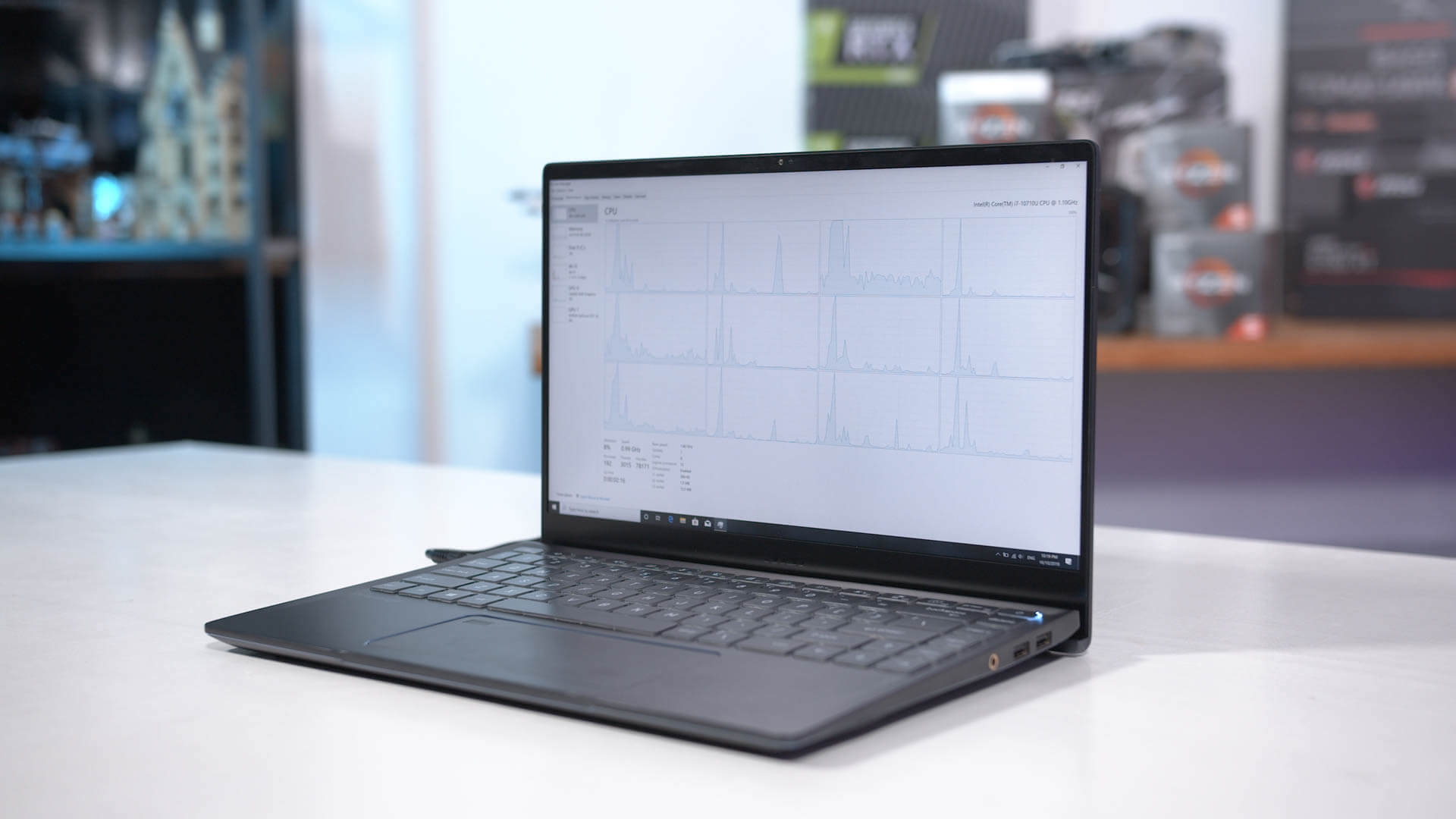
We got admission to an engineering sample as opposed to a final retail model of the Prestige, meaning there are some early bug with this laptop that we look will exist resolved come the retail release. Only this isn't a laptop review, we're instead focused on how the 10710U performs.
Of notation, there are a few different operation profiles. The "counterbalanced" mode in MSI's Creator app sets this laptop to the CPU'due south default 15W configuration. That is 15W on the long term PL1 power limit, and 45W on the PL2 limit. Using the "high performance" style bumps this upward to the maximum 25W configuration: 25W PL1 and 51W PL2. These power figures are similar to previous generation laptops, so we'll be able to draw a few comparisons.

Turbo boost durations do differ between laptops as each OEM can configure that individually, so there will be some variance among models specially for short term tests. Only these numbers nosotros're most to get through should still exist representative of typical i7 10710U functioning, especially in longer workloads where the CPU sits at its PL1 limit.
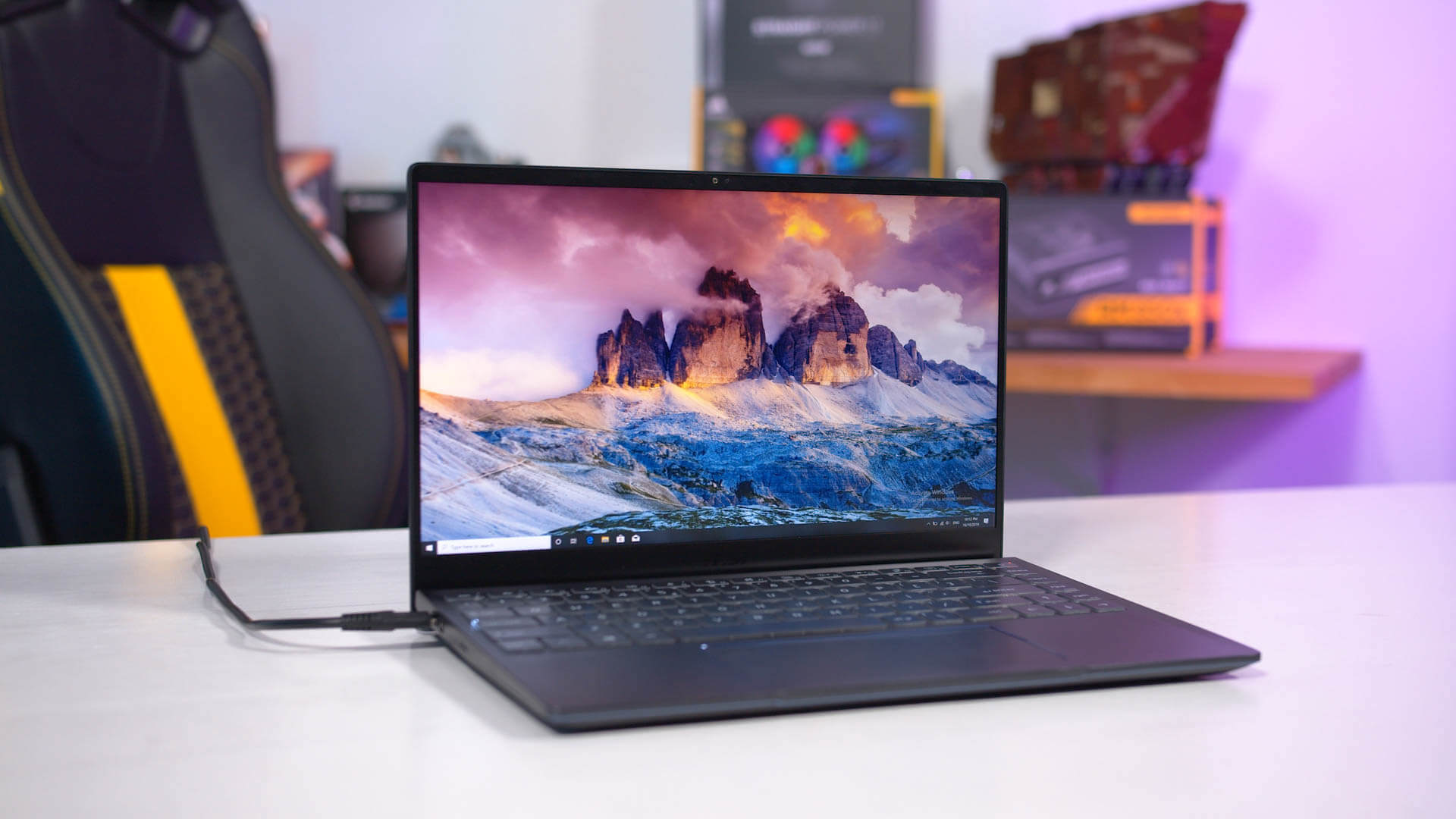
Because we're solely focused on CPU and iGPU performance in this review, we disabled the discrete GPU for these tests. The GTX 1650 Max-Q gives this laptop a huge boost in compute or graphics workloads but that's non our concern right at present.
Benchmarks
Nosotros'll offset with something Intel has begged reviewers not to apply: Cinebench. While it'south true that yous probably won't use a 15W laptop CPU to render 3D models, Cinebench is nonetheless a dandy benchmarking platform to explore unmarried and multi-threaded performance and how that compares to other products on the market.
The Cadre i7-10710U posts a really impressive score in the multi-threaded workload for just a 15W processor. It's easily the fastest 15W scrap in this list, coming in 33 percentage faster than the Cadre i7-8565U. Yep, we are getting 50% more cores, just clock speeds have been reduced to fit within 15W, so getting this extra performance bump is very decent.

You lot'll likewise meet the Core i7-10710U is only marginally behind the 35-45W quad-cadre Core i7-7700HQ from a few generations ago, and basically equivalent to the 25W configuration of the Core i7-8565U. So even though Intel has been stuck on 14nm in the three years since the launch of Kaby Lake, they've managed to bring a like level of multi-threaded performance to a much lower power level with more cores and optimizations.
Now y'all might exist wondering, how is this possible? Is Intel cheating the TDP and running outside 15W in long term workloads, like we've seen with desktop processors? The answer to this is no. As far as we can tell, the CPU does gradually drop down to 15W for longer term workloads. Certainly in that location has been a heave for short term workloads, which at present use up to 45W of power, merely a significant chunk of Cinebench is capped within the PL1 limit.
The reason for this comes down to the non-linear nature of voltage-clock speed curves. When y'all reduce clock speeds slightly, depending on the process node you can become significant improvements to ability consumption.
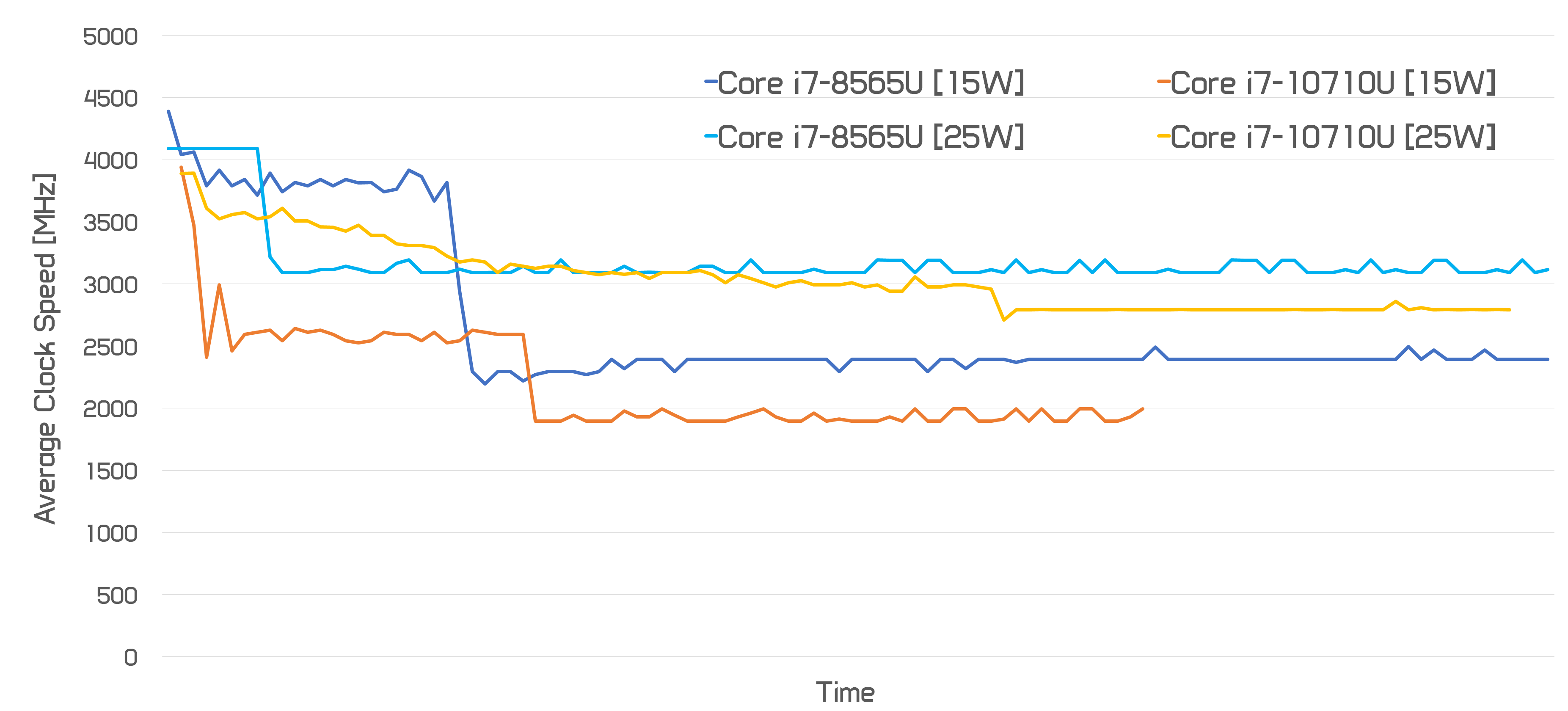
When looking at this clock speed nautical chart for Cinebench, y'all tin see the i7-8565U runs at effectually two.four GHz long term in its 15W configuration, or over 3.0 GHz at 25W, across four cores. The Core i7-10710U runs at just 1.9 GHz at 15W beyond six cores, so that's 500 MHz lower than the previous-gen quad-cores, or more than than a GHz lower comparing 15W to 25W.
Had Intel dropped their last-gen quad-core chip to 1.nine GHz, they'd get a big drop in power consumption. They've then used that freed up power budget to introduce ii extra cores, bringing the scrap back up to 15W. The equation works out so nicely that the extra cores more than than compensate for the dropped clocks in this type of workload in terms of performance, hence why nosotros become more operation at the same ability consumption, simply through increased parallelization and running these cores at more efficient clocks.
You lot'll observe a few other things from this Cinebench chart. Single-thread performance is around the same marker comparison tenth-gen to 8th-gen, because unmarried core turbo frequencies are about the same. At 25W, we also see a large functioning gain over the Core i7-8565U, however we're not at the level of the 45W six-core Core i7-8750H or i7-9750H. Those beefed upward chips with higher power limits are xviii% faster, so you can meet the 25W 10710U is more efficient but it merely can't lucifer the performance of those college-end fries.
x264 encoding is another good multi-threaded benchmark, and video encoding is a popular task even if it's only converting files to play them. Once once again we encounter the 10710U come in around 25% faster than the 8565U, whether nosotros look at 15W or 25W configurations. However, for those that do a lot of video encoding, getting a 9750H system still makes sense with up to 37% more performance compared to the 25W version of Intel's new tenth-gen chip.

In Handbrake, despite moving to the more intensive x265 encoding library, things aren't too different from what we saw with x264 encoding. Generation-on-generation we're looking at 24% more than performance comparing 15W models, and 20% comparing 25W models. Over again, still around that 33% boost when upgrading from a 10710U 25W model to the 9750H, merely given you can now become 7700HQ-similar performance in a slim and light arrangement with 25W of cooling chapters, we're very impressed with what Intel has done.

Let'south become through some more encoding benchmarks. Blender is an interesting compute benchmark because nosotros run this on the CPU and GPU and take the lowest score, giving us an indication of the overall compute power of a laptop. After all, nosotros wouldn't desire to disadvantage systems that tin can run the task on the GPU faster than the CPU.

For almost of these ultraportable results, we're running on the CPU, and then nosotros see similar margins to what we've been talking about. Almost a 30% gen-on-gen improvement moving from four to six cores. However the interesting results here are perhaps these Ryzen comparisons. Equally we know, Ryzen Mobile has a much more powerful GPU than Intel'due south Comet Lake, and we see these Ryzen laptops running this benchmark on the GPU. However, the Core i7-10710U can nigh catch information technology on the CPU solitary, which shows the strength of this half dozen-core configuration.
Our Premiere criterion relies on both CPU and GPU horsepower simultaneously, every bit nosotros're encoding a 4K file with GPU accelerated Lumetri effects. Typically speaking, these ultraportable CPUs asphyxiate under the GPU demands, which is why nosotros don't see much difference in performance between the diverse 15 and 25W models without a discrete GPU. As soon as you add a discrete GPU into the mix, this encode absolutely flies.

In our non Lumetri benchmark which is a bit lighter on the GPU requirements, we see a small-scale gain for the i7-10710U over the i7-8565U. You'll notwithstanding desire a discrete GPU here though, and in full general for Premiere with any sort of effects applied, your buying decision with this class of laptop could come up more down to the GPU you get, rather than the CPU.

What about something that's not encoding... One time again, 6 cores is a big improvement in seven-Zilch, offer around 30% more than performance compared to Whiskey Lake. Given this is a short-run workload that by and large operates in the boost clock region, Intel's steady increasing of boost clocks and turbo power limits has helped here as well, peculiarly compared to CPUs from a few generations ago like the Core i7-7700HQ.

Adobe Photoshop Iris Blur is an effect that's generally CPU, cache and retentivity limited. We're just seeing modest gains for the 10710U over the 8565U, to the tune of ~x% which is a bit lower than we've seen from other, more intensive tests. In that location's as well less of an advantage from moving to Intel's higher TDP six-core CPUs, though the reward is still there.

Photoshop's Smart Sharpen filter goes the other way, and becomes GPU limited. Given we aren't getting anything new with the UHD 620 GPU, it'southward no surprise to see the Cadre i7-10710U matching other 15W processors.

MATLAB is a workload that isn't dependent on annihilation just retention and cache, so here nosotros don't run across much movement or improvement in performance. Comet Lake does support LPDDR4x but our laptop test system is however using DDR4.

Before we wrap this up, here's some other expect at GPU operation. Without any improvement to the integrated GPU we aren't seeing an improvement to CompuBench compute performance in optical flow. Calculation something similar an MX150 is necessary for respectable GPU operation.

Performance Summary
Nosotros'll start with a generation on generation wait with the Core i7-10710U versus the Cadre i7-8565U in their 15W configurations. Performance here does vary a bit depending on whether the criterion is multi-threaded or single-threaded, just in general we're looking at a 25 to 30% improvement in multi-threaded performance going from 4 to six cores. That's pretty excellent with such a tight ability limit.
Core i7-10710U vs Core i7-8565U

Unmarried-core gains are most non-existent more often than not because the CPU core architecture itself is unchanged from prior generations, and at least with this six-cadre blueprint, we aren't getting an comeback in heave clocks. Not that the CPU even reaches the boost clock in longer unmarried-core workloads, because in that location simply isn't enough power budget to practice so. At the absolute best we're getting two-3% more performance, and we'd say that'southward all downwardly to process optimizations and binning.

The integrated GPU is besides unchanged, and so again no performance gains there. This is important for workloads like Premiere which rely on GPU dispatch. We expect lots of designs to come out with detached GPUs – the MSI Prestige 14 has a GTX 1650 Max-Q for case – which will give a decent heave to GPU horsepower.

When comparing 25W models, it's a similar story, without as much of a gain in unmarried-threaded workloads. Here the six-core can even be slower in some situations, but we're notwithstanding getting that ~thirty% improvement in multi-threaded workloads.
If you're wondering about 15W versus 25W, well if you're lucky enough to go a laptop that can be run at 25W, you're looking at a decent 30% gain in some workloads, or more minor single digit gains in others. Given long term ability consumption is 40% college with the cTDP Upwardly configuration we're moving away from the efficiency sweet spot, but for some, the extra performance is all that matters.
Cadre i7-10710U vs. Core i7-7700HQ vs. Core i7-9750H
These next comparisons are some of the most interesting in my opinion. The i7-10710U at 15W isn't that far off the i7-7700HQ in most workloads. Performance isn't quite equivalent, but Intel has been able to edge towards replicating 45W performance from iii years ago with a 15W fleck, without any major leaps in process tech. People love to laugh at 14nm++ and that is kind of truthful on the desktop, merely in these power optimized CPUs, information technology seems to be making a bit of a difference when Intel can add more than cores into the mix equally well.

Intel hasn't reached the bespeak where their 25W U-series chip can compete with 45W H-series models. The i7-9750H is still xxx% faster or and so in crucial workloads like video encoding, so don't go ditching your fifteen-inch H-series laptop just all the same because a six-core U-series CPU doesn't stack upwardly as expected.

Core i7-10710U vs. Ryzen 7 3750H
The launch of Comet Lake isn't adept news for AMD. The Core i7-10710U is, in our opinion, a much better option than even the Ryzen vii 3750H, and we're talking well-nigh a 15W CPU vs 35W here. These CPUs trade blows, despite the 3750H featuring much college power requirements, and impressively the 10710U fifty-fifty beats information technology in workloads similar Handbrake and especially anything unmarried threaded. The merely reward the 3750H has is a much faster integrated GPU, but that can disappear easily with a discrete GPU pairing, which is becoming more common.

It's even worse when you give the Cadre i7-10710U a bit more than power to play with. Ryzen gets badly browbeaten here, and we're not even comparing U-series to U-series which is even more of a bloodbath. AMD tin can't get Zen 2 based designs hither fast enough, where we expect the significant changes to architecture and the introduction of 7nm to bring massive gains in the depression power space.

Wrap Upwardly
Seeing Intel achieve the limits of their 14nm procedure, we genuinely weren't expecting the Core i7-10710U to be this adept. At 15W we happen to exist right in the sweet spot for an efficient six cadre design, which allows for up to thirty% more functioning in multi-threaded workloads. We aren't getting many other improvements, but for buyers of ultraportable systems and with the increasing usage of multi-threading, this is very decent.
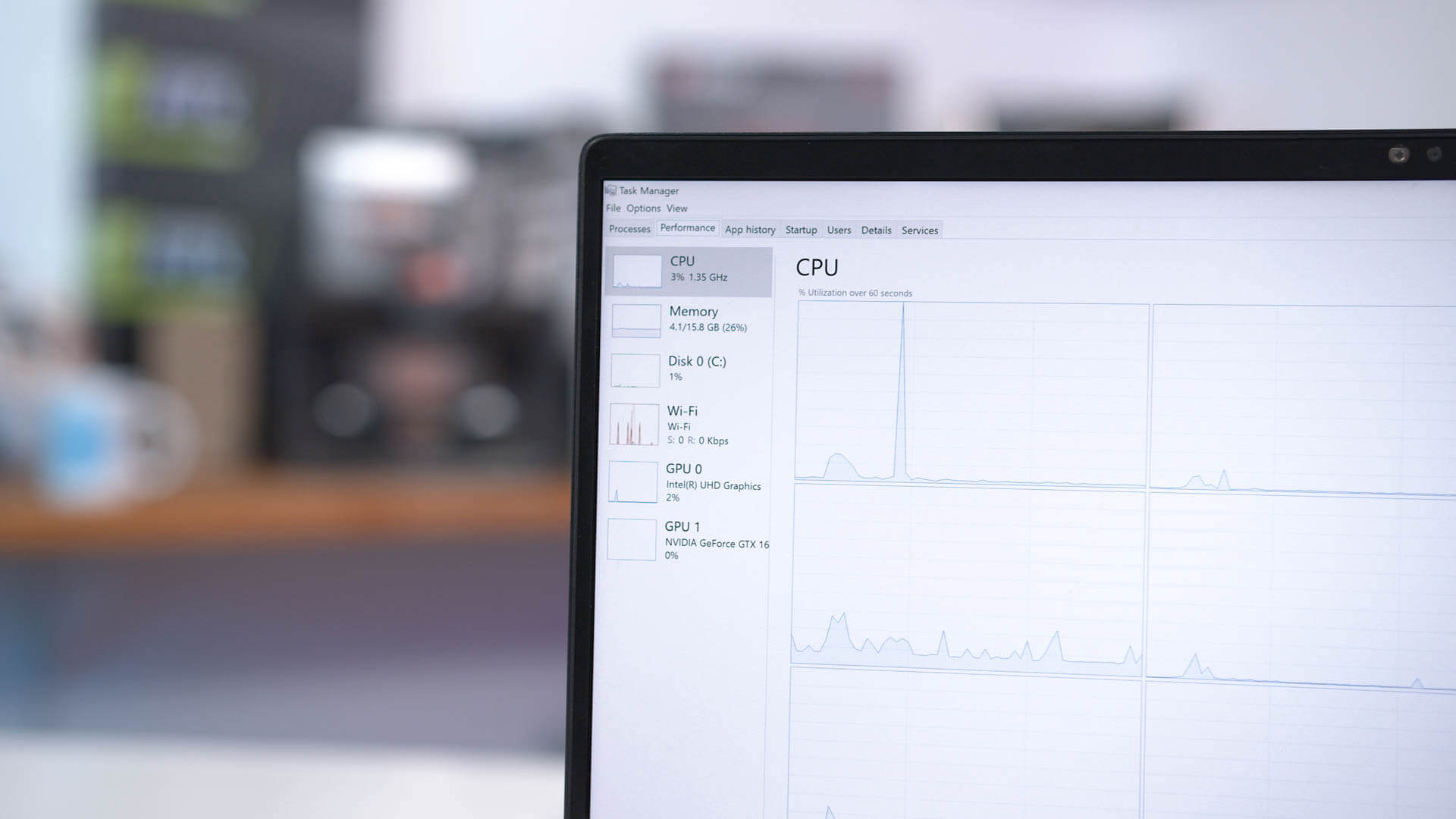
Anyone looking to upgrade their slim and calorie-free motorcar should be able to detect performance gains even over a quad-core from the by few generations, although you'll accept to specifically expect for a Core i7-10710U as it'due south the only six-core model. If you're coming from a dual-cadre, you'll be blasted into a new dimension with all the extra functioning you'll go. Seriously, those dual-core Intel U-series processors are slow these days.
It'll exist interesting to meet how Ice Lake stacks up. Nosotros know they are clocked lower, but given U-series chips typically hover in the mid two GHz range with four cores, this may not be a trouble. And the improved integrated graphics might come handy, but they might also become easily outpaced by a Comet Lake CPU with a discrete GPU, like is plant in this MSI Prestige notebook. Time volition tell.
Shopping Shortcuts
- Core i7-10710U Laptops on Amazon
- Core i7-8565U Laptops on Amazon
- Core i7-10510U Laptops on Amazon
- Ryzen vii 3700U Laptops on Amazon
- Ryzen 7 3750H Laptops on Amazon
Further Reading
- The Best Laptops 2022
- Reasons to Upgrade Your Laptop (That Go Beyond a Performance Upgrade)
- Desktop vs. Laptop Gaming with the RTX 2070
Source: https://www.techspot.com/review/1926-intel-core-i7-10710u/
Posted by: mccraythiscoady.blogspot.com


0 Response to "Intel Core i7-10710U Benchmarked: 14nm+++ Comet Lake"
Post a Comment